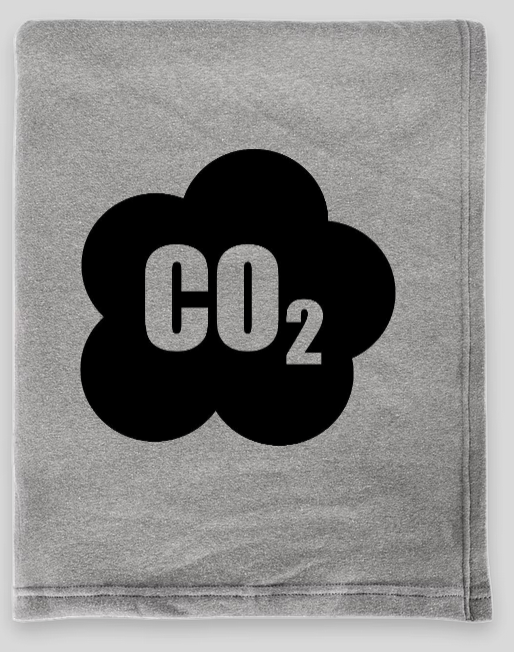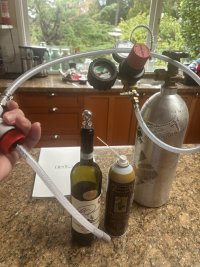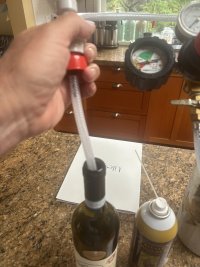There is no "P" in CO2At least we're talking about a CO2 duvet, not bidet, even if those might also be underrated..
I forgot where I was going with this , , , sorry. ;]
You are using an out of date browser. It may not display this or other websites correctly.
You should upgrade or use an alternative browser.
You should upgrade or use an alternative browser.
Can we dispel the myth of the 'CO2 Blanket' ?
- Thread starter Zadkiel
- Start date

Help Support Homebrew Talk:
This site may earn a commission from merchant affiliate
links, including eBay, Amazon, and others.
The lifetime of the "blanket" is minutes if the cover is taken off of a bucket fermenter.
I strongly disagree, and I have trouble reconciling you saying this with you liking my post back on page 1 about fluid dynamics, BUT thankfully, despite disagreeing on this, we both agree on the more important fact, which is that regardless of what happens to the CO2, the O2 ingress is instantly significant.
Oxygen in fermenter (after "primary" fermentation) bad. Frankenstein no like oxygen in fermenter. Frankenstein like blanket.
- Joined
- May 6, 2025
- Messages
- 337
- Reaction score
- 270
Look. CO2 is clearly an effective protective blanket, and in three scenarios.
First, have Muhammed Ali do the dry hopping.
"I'm so fast! I'm so fast I turn off the light and I'm in bed before the room gets dark!. I"m fast!"
Second, just do your brewing on a neutron star. Gravity is 10 to the 11 decimals earth gravity. The blanket of CO2 will be dense enough to resist diffusion. And the lack of an atmosphere will also help.
Third, use a hop bong.
First, have Muhammed Ali do the dry hopping.
"I'm so fast! I'm so fast I turn off the light and I'm in bed before the room gets dark!. I"m fast!"
Second, just do your brewing on a neutron star. Gravity is 10 to the 11 decimals earth gravity. The blanket of CO2 will be dense enough to resist diffusion. And the lack of an atmosphere will also help.
Third, use a hop bong.
Second, just do your brewing on a neutron star. Gravity is 10 to the 11 decimals earth gravity. The blanket of CO2 will be dense enough to resist diffusion. And the lack of an atmosphere will also help.
Don't be ridiculous. An extension cable to your fermentation fridge wouldn't work over that long of a length. DUH!
The lifetime of the "blanket" is minutes if the cover is taken off of a bucket fermenter. But once you take the cover off, O2 gets into the top of the headspace in less than a second, and the O2 concentration near the top of the fermenter increases rapidly from there, even if very little O2 has made it to the surface of the beer. When you put the lid back on, all of the O2 that entered the headspace is still in the fermenter, and significant amounts will diffuse to the surface of the beer in minutes. The O2 at the surface of the beer will start diffusing into the beer, and if you don't have ongoing yeast activity to consume the O2 by bio-chemical means, it will start to oxidize beer components.
The oxidation is slow compared to the interdiffusion of O2 and CO2, but as the oxidation occurs, the concentration of free O2 in the beer drops, allowing more O2 to diffuse into the beer from the headspace.
If there was no oxidation or O2 consumption going on, then eventually the O2 concentration in the beer would reach equilibrium with the O2 partial pressure in the headspace. But if there is oxidation or consumption then the O2 concentration in the beer doesn't reach equilibrium with the O2 in the headspace, and eventually essentially all of the O2 in the headspace will end up in the beer.
Brew on
So would the real answer be not that you have to dry hop and put the lid back on within 1 second, but merely that you should dry hop before you've reached 100% complete fermentation? Because if you still have ongoing fermentation activity, the yeast will still be able to handle the O2...
Or am I off base here...

$45.74 ($45.74 / Count)
Brewer's Best Home Brew Beer Ingredient Kit - 5 Gallon (Grapefruit IPA)
Amazon.com

$7.79 ($7.79 / Count)
Craft A Brew - LalBrew Voss™ - Kveik Ale Yeast - For Craft Lagers - Ingredients for Home Brewing - Beer Making Supplies - (1 Pack)
Craft a Brew

$53.24
1pc Hose Barb/MFL 1.5" Tri Clamp to Ball Lock Post Liquid Gas Homebrew Kegging Fermentation Parts Brewer Hardware SUS304(Gas MFL)
yunchengshiyanhuqucuichendianzishangwuyouxiangongsi

$82.50
Wilbur Curtis Brew Cone Assembly with Splash Pocket, High Volume - Commercial-Grade Brew Basket - WC-3422 (Each)
Global Commercial Parts

$58.16
HUIZHUGS Brewing Equipment Keg Ball Lock Faucet 30cm Reinforced Silicone Hose Secondary Fermentation Homebrew Kegging Brewing Equipment
xiangshuizhenzhanglingfengshop

$20.94
$29.99
The Brew Your Own Big Book of Clone Recipes: Featuring 300 Homebrew Recipes from Your Favorite Breweries
Amazon.com

$53.24
1pc Hose Barb/MFL 1.5" Tri Clamp to Ball Lock Post Liquid Gas Homebrew Kegging Fermentation Parts Brewer Hardware SUS304(Gas Hose Barb)
Guangshui Weilu You Trading Co., Ltd

$176.97
1pc Commercial Keg Manifold 2" Tri Clamp,Ball Lock Tapping Head,Pressure Gauge/Adjustable PRV for Kegging,Fermentation Control
hanhanbaihuoxiaoshoudian
![Craft A Brew - Safale S-04 Dry Yeast - Fermentis - English Ale Dry Yeast - For English and American Ales and Hard Apple Ciders - Ingredients for Home Brewing - Beer Making Supplies - [1 Pack]](https://m.media-amazon.com/images/I/41fVGNh6JfL._SL500_.jpg)
$6.95 ($17.38 / Ounce)
$7.47 ($18.68 / Ounce)
Craft A Brew - Safale S-04 Dry Yeast - Fermentis - English Ale Dry Yeast - For English and American Ales and Hard Apple Ciders - Ingredients for Home Brewing - Beer Making Supplies - [1 Pack]
BellaRae

$22.00 ($623.23 / Ounce)
AMZLMPKNTW Ball Lock Sample Faucet 30cm Reinforced Silicone Hose Secondary Fermentation Homebrew Kegging joyful
无为中南商贸有限公司

$10.99 ($31.16 / Ounce)
Hornindal Kveik Yeast for Homebrewing - Mead, Cider, Wine, Beer - 10g Packet - Saccharomyces Cerevisiae - Sold by Shadowhive.com
Shadowhive
So would the real answer be not that you have to dry hop and put the lid back on within 1 second, but merely that you should dry hop before you've reached 100% complete fermentation? Because if you still have ongoing fermentation activity, the yeast will still be able to handle the O2...
Or am I off base here...
Unfortunately, it's not that simple. Remember, gasses readily mix. So just opening the fermenter allows oxygen ingress (and it's never 100% co2 anyway).
If there really was a CO2 blanket, we'd all die in our sleep every single night.
Right, but what Doug was pointing out (the bit that I bolded) was that as long as there's still yeast activity, the yeast might consume any oxygen that has entered the fermenter.Unfortunately, it's not that simple. Remember, gasses readily mix. So just opening the fermenter allows oxygen ingress (and it's never 100% co2 anyway).
Obv this can be dependent on a lot of things. I ferment larger (10 gal) batches in a fermenter with a very narrow opening, so I'll have more volume of beer, less oxygen ingress, and more yeast to do the job... Whereas someone doing 5 gal batches in a bucket will have a lot more oxygen ingress because of they large opening, 1/2 the volume of beer which is then effectively double the ppm uptake that the yeast have to deal with, and less yeast to handle it. So on a relative level, it might mean I'm more safe than the person fermenting 5 gallons in buckets.
But ignore the quantities involved to think of it more theortically... The question would be that if you're only, say, 80% of the way to your target FG, does that mean the yeast is still capable of cleaning up some/all of the O2 that you might introduce during dry hopping?
You might research Hop Creep. Obviously you can decide if the negative aspects of hopping during active fermentation outweigh the benefits but I think the conventional wisdom is leaning towards dropping the yeast out of suspension before dry hopping so the two don’t mix. YMMVRight, but what Doug was pointing out (the bit that I bolded) was that as long as there's still yeast activity, the yeast might consume any oxygen that has entered the fermenter.
Obv this can be dependent on a lot of things. I ferment larger (10 gal) batches in a fermenter with a very narrow opening, so I'll have more volume of beer, less oxygen ingress, and more yeast to do the job... Whereas someone doing 5 gal batches in a bucket will have a lot more oxygen ingress because of they large opening, 1/2 the volume of beer which is then effectively double the ppm uptake that the yeast have to deal with, and less yeast to handle it. So on a relative level, it might mean I'm more safe than the person fermenting 5 gallons in buckets.
But ignore the quantities involved to think of it more theortically... The question would be that if you're only, say, 80% of the way to your target FG, does that mean the yeast is still capable of cleaning up some/all of the O2 that you might introduce during dry hopping?
- Joined
- Oct 12, 2020
- Messages
- 3,599
- Reaction score
- 7,041
Ok then fine!... use a CO2 blanket if you must, but be aware; It will cause you to have autistic kids (https://www.autisticculturepodcast.com/p/episode-8-peanuts-is-autistic) I'll stick with wool, cotton, linen or other natural fibres.


Right, but what Doug was pointing out (the bit that I bolded) was that as long as there's still yeast activity, the yeast might consume any oxygen that has entered the fermenter.
Obv this can be dependent on a lot of things. I ferment larger (10 gal) batches in a fermenter with a very narrow opening, so I'll have more volume of beer, less oxygen ingress, and more yeast to do the job... Whereas someone doing 5 gal batches in a bucket will have a lot more oxygen ingress because of they large opening, 1/2 the volume of beer which is then effectively double the ppm uptake that the yeast have to deal with, and less yeast to handle it. So on a relative level, it might mean I'm more safe than the person fermenting 5 gallons in buckets.
But ignore the quantities involved to think of it more theortically... The question would be that if you're only, say, 80% of the way to your target FG, does that mean the yeast is still capable of cleaning up some/all of the O2 that you might introduce during dry hopping?
No, probably won’t clean up “all” of the 02 since alcohol fermentation by yeast is an anaerobic process. Sure, they use oxygen to reproduce, but once reproduction is done at the beginning, it turns into an anaerobic fermentation process. That is WAY oversimplifying of course, but oxygen ingress after fermentation is underway is generally not favorable unless it’s a huge huge beer that needs some assistance with yeast reproduction a bit further along. For example, I stir my wine caps down during the first few days, not really just to add oxygen, but to keep the cap from drying out and molding, and to drive off c02. C02 is poisonous to yeast.
But once fermentation slows, the wine goes under airlock and is then even sulfited to prevent oxidation.
No, probably won’t clean up “all” of the 02 since alcohol fermentation by yeast is an anaerobic process. Sure, they use oxygen to reproduce, but once reproduction is done at the beginning, it turns into an anaerobic fermentation process. That is WAY oversimplifying of course, but oxygen ingress after fermentation is underway is generally not favorable unless it’s a huge huge beer that needs some assistance with yeast reproduction a bit further along. For example, I stir my wine caps down during the first few days, not really just to add oxygen, but to keep the cap from drying out and molding, and to drive off c02. C02 is poisonous to yeast.
But once fermentation slows, the wine goes under airlock and is then even sulfited to prevent oxidation.
Yes, yeast goes into anaerobic fermentation mode once the O2 is gone (it has no other choice), but the fact that we can repitch yeast demonstrates that yeast can return to aerobic fermentation mode when reintroduced to O2 in the presence of food (fermentable sugar.) I am by no means a yeast metabolism expert, but it seems reasonable that yeast will at least partially revert to some aerobic activity if O2 becomes availalble in the presence of fermentable sugar.
Brew on

Obv this can be dependent on a lot of things. I ferment larger (10 gal) batches in a fermenter with a very narrow opening, so I'll have more volume of beer, less oxygen ingress, and more yeast to do the job... Whereas someone doing 5 gal batches in a bucket will have a lot more oxygen ingress because of they large opening, 1/2 the volume of beer which is then effectively double the ppm uptake that the yeast have to deal with, and less yeast to handle it. So on a relative level, it might mean I'm more safe than the person fermenting 5 gallons in buckets.
I think you have a good grasp of some of the factors that affect the rate of O2 ingress, and the ratio of O2 to beer. These are some of the things that make this question intractable from a calculation perspective.
Brew on

Anyone want to buy a $100 CO2 meter and actually put this blanket thing to bed? Pun intended.
What about this: would it help to increase the CO2 concentration in the top of the fermenter by dropping in a 20 g chunk of dry ice right after opening it?
the CO2 levels are less important, the main issue is the image of this 'CO2 blanket' as some repelling magical force field stopping anything else from getting in. If you want to add scientific proof to debunking the myth, you'd need an O2 meter, inside the fermenter, capable of registering 1ppm.Anyone want to buy a $100 CO2 meter and actually put this blanket thing to bed? Pun intended.
Or we could just use common sense and accept that O2 will get inside and save the time and money.
Snuffy
He ain't scared.
- Joined
- Nov 5, 2019
- Messages
- 1,944
- Reaction score
- 3,109
<cough cough> Harsh, dude.Third, use a hop bong.
PCABrewing
Recreational Brewer
- Joined
- Oct 28, 2021
- Messages
- 1,055
- Reaction score
- 1,283
That's been my approach for years.Or we could just use common sense and accept that O2 will get inside and save the time and money.
I can't say you are totally wrong but you are not totally right either. Oxidation is a perpetual process. Your starting point determines a lot of the outcome. Let me explain...The only experience I've personally had with oxidation has not been in kegs or in bottles, but has been in growlers. So I do think I'm probably overly paranoid, but it's possible that very paranoia that has protected my beers from oxidation.
When I transfer to a bottling bucket, I do it so it's just the beer going through the tubing into the priming sugar at a slow rate with zero splashing or anything. I cover the top of the bottling bucket with saran wrap (or sometimes just the lid. But it doesn't change the fact that the bottling bucket is full of air and the beer is constantly in contact with the air until the bottling process is complete. It makes me very uneasy, even though I honestly have only experienced oxidations in growlers so far.
If you brewed a totally no-oxygen beer, your starting point would be all malt flavor and no oxidation flavor. In contrast, if you brewed a splishy splashy oxygen fireball, your starting point point would be filled with oxidation flavor.
Remember that another homebrew myth is that oxidation = cardboard. In reality, oxidation starts very subtle and grows in intensity given the right circumstances. So as brewers, were are just trying to limit the negative circumstances. But, until one brews a beer with low oxygen process', the starting point will already have plenty of oxidation flavor baked in. In my view, this leads to folks saying they have never experienced oxidation flavors. Well, the flavor is already there and often gets associated with malt sweetness. The distance from the flavor being present to cardboard can be long.
Limiting oxygen gets associated with NEIPAs and other hop forward beers because the loss of hop aroma due to oxygen can be quite obvious. But the same factors are at work with malt flavor as well.
Whether it helps or not I definitely want to see the video.would it help to increase the CO2 concentration in the top of the fermenter by dropping in a 20 g chunk of dry ice right after opening it?
In reality, you need an O2 meter that can resolve down to 0.01 ppm, since the target total dissolved O2 is ~0.1 ppm.the CO2 levels are less important, the main issue is the image of this 'CO2 blanket' as some repelling magical force field stopping anything else from getting in. If you want to add scientific proof to debunking the myth, you'd need an O2 meter, inside the fermenter, capable of registering 1ppm.
Or we could just use common sense and accept that O2 will get inside and save the time and money.
Brew on

I find the total dissolved O2 threshold fascinating. Even "food grade" liquid CO2 has a threshold of 30 PPMv oxygen content and well known breweries use it for bottling and displacement, maybe even forced carbonation. Any way you look at it, I assume our CO2 bottles have over 10 PPM oxygen supplying our process. Must be a very low adsorption rate into liquid when headspace volume/pressure is accounted for. I am not that concerned yet, but I digress...
The word blanket is the cause of some confusion with mental image of a solid barrier. Ordering Christmas presents for 2025 now

The word blanket is the cause of some confusion with mental image of a solid barrier. Ordering Christmas presents for 2025 now

Remember that the density of beer is about 1,000x the density of the gases in the headspace and the headspace volume (in a bottle or keg) is usually only about 6% of the beer volume. So 30 ppm oxygen in your CO2 tank becomes less than 2 ppb oxygen dissolved in the beer.Even "food grade" liquid CO2 has a threshold of 30 PPMv oxygen content and well known breweries use it for bottling and displacement, maybe even forced carbonation. Any way you look at it, I assume our CO2 bottles have over 10 PPM oxygen supplying our process. Must be a very low adsorption rate into liquid when headspace volume/pressure is accounted for.
- Joined
- May 6, 2025
- Messages
- 337
- Reaction score
- 270
Ok, there is a situation where co2 is an effective blanket. Sort of.
The wine stores sell pressurized bottles of wine preserver. It is argon with some carbon dioxide. If you have wine left in the bottle after dinner, you insert the thin tube into the bottle and inject a couple inches of inert gas.
They sell it as a system that protects your wine from oxidizing, so that the next evening you can enjoy the remains of the bottle.
It is based on that "protective carpet of co2" theory that we all know and hate.
The thing is, it does work, a little bit. Sure, the gases mix right away. But the resulting mixture involves slightly reduced oxygen.
If you do nothing, the wine is badly oxidized the next day. I have to dump the remains of the wine. With this method, it's actually ok the next evening and I can drink it. But the day after that, forget it. It is badly oxidized and I have to pour it out.
The system works because usually, the next night you'll finish the wine. It's a crappy system, but it only has to work for 24 hours.
How to improve on this?
Look at the photos. I insert a hose from my co2 bottle, down to just above the remains of the wine. With the pressure low, I purge everything out of the bottle, until there is nothing but co2 in the bottle. Then while the hose is still pouring out co2, I pull it out of the bottle and cork the bottle. Similar concept to the hop bong.
Really what is happening is that the protective blanket is the cork.
The wine stores sell pressurized bottles of wine preserver. It is argon with some carbon dioxide. If you have wine left in the bottle after dinner, you insert the thin tube into the bottle and inject a couple inches of inert gas.
They sell it as a system that protects your wine from oxidizing, so that the next evening you can enjoy the remains of the bottle.
It is based on that "protective carpet of co2" theory that we all know and hate.
The thing is, it does work, a little bit. Sure, the gases mix right away. But the resulting mixture involves slightly reduced oxygen.
If you do nothing, the wine is badly oxidized the next day. I have to dump the remains of the wine. With this method, it's actually ok the next evening and I can drink it. But the day after that, forget it. It is badly oxidized and I have to pour it out.
The system works because usually, the next night you'll finish the wine. It's a crappy system, but it only has to work for 24 hours.
How to improve on this?
Look at the photos. I insert a hose from my co2 bottle, down to just above the remains of the wine. With the pressure low, I purge everything out of the bottle, until there is nothing but co2 in the bottle. Then while the hose is still pouring out co2, I pull it out of the bottle and cork the bottle. Similar concept to the hop bong.
Really what is happening is that the protective blanket is the cork.
Attachments
I find the total dissolved O2 threshold fascinating. Even "food grade" liquid CO2 has a threshold of 30 PPMv oxygen content and well known breweries use it for bottling and displacement, maybe even forced carbonation. Any way you look at it, I assume our CO2 bottles have over 10 PPM oxygen supplying our process. Must be a very low adsorption rate into liquid when headspace volume/pressure is accounted for. I am not that concerned yet, but I digress...
The word blanket is the cause of some confusion with mental image of a solid barrier. Ordering Christmas presents for 2025 now
View attachment 885296
30ppm is the spec for max O2 allowed. Turns out that the equipment for testing to a lower spec gets much more expensive, so the spec was set at a level that wasn't too expensive to test and assure. I remember seeing a paper where bev grade CO2 was tested with appropriately sensitive equipment, and the actual O2 concentration was down around 0.05 ppm (50 ppb.) Unfortunately, I didn't save a copy of the paper, and I haven't been able to find it again.
Brew on

Ok, there is a situation where co2 is an effective blanket. Sort of.
The wine stores sell pressurized bottles of wine preserver. It is argon with some carbon dioxide. If you have wine left in the bottle after dinner, you insert the thin tube into the bottle and inject a couple inches of inert gas.
They sell it as a system that protects your wine from oxidizing, so that the next evening you can enjoy the remains of the bottle.
It is based on that "protective carpet of co2" theory that we all know and hate.
The thing is, it does work, a little bit. Sure, the gases mix right away. But the resulting mixture involves slightly reduced oxygen.
If you do nothing, the wine is badly oxidized the next day. I have to dump the remains of the wine. With this method, it's actually ok the next evening and I can drink it. But the day after that, forget it. It is badly oxidized and I have to pour it out.
The system works because usually, the next night you'll finish the wine. It's a crappy system, but it only has to work for 24 hours.
How to improve on this?
Look at the photos. I insert a hose from my co2 bottle, down to just above the remains of the wine. With the pressure low, I purge everything out of the bottle, until there is nothing but co2 in the bottle. Then while the hose is still pouring out co2, I pull it out of the bottle and cork the bottle. Similar concept to the hop bong.
Really what is happening is that the protective blanket is the cork.
None of that is a "protective blanket". It's all just diluting how much O2 is in the headspace. And yes, the lower the better, and the longer it will take for significant oxidation to occur and the damage to become apparent. But, if the concentration isn't low enough, you will get perceivable oxidation damage over time.
The "protective blanket" concept is that there is a persistent layer of CO2, covering the surface of the liquid, that prevents O2 from getting to the beer (or other beverage.) This concept is nonsense.
Brew on

A guy at Linde once told me that their CO2 actually all starts out the same but the filling and testing equipment differs. I have no idea whether he was just blowing smoke, but it kinda sorta almost sounds plausible.30ppm is the spec for max O2 allowed. Turns out that the equipment for testing to a lower spec gets much more expensive, so the spec was set at a level that wasn't too expensive to test and assure.
- Joined
- May 6, 2025
- Messages
- 337
- Reaction score
- 270
None of that is a "protective blanket". It's all just diluting how much O2 is in the headspace. And yes, the lower the better, and the longer it will take for significant oxidation to occur and the damage to become apparent. But, if the concentration isn't low enough, you will get perceivable oxidation damage over time.
The "protective blanket" concept is that there is a persistent layer of CO2, covering the surface of the liquid, that prevents O2 from getting to the beer (or other beverage.) This concept is nonsense.
Brew on
Yes, the word "blanket" is incorrect and will mislead people into letting their beer age into bad oxidation.
But I think the exception is the hop bong concept. That is not dilution. That is removal of all oxygen in the vessel. I think it's cool how many methods we are devising for this. Starsan purge of a serving keg is another example.
Similar threads
- Replies
- 0
- Views
- 1K
- Replies
- 1
- Views
- 3K
- Replies
- 83
- Views
- 8K
- Replies
- 85
- Views
- 11K


















































